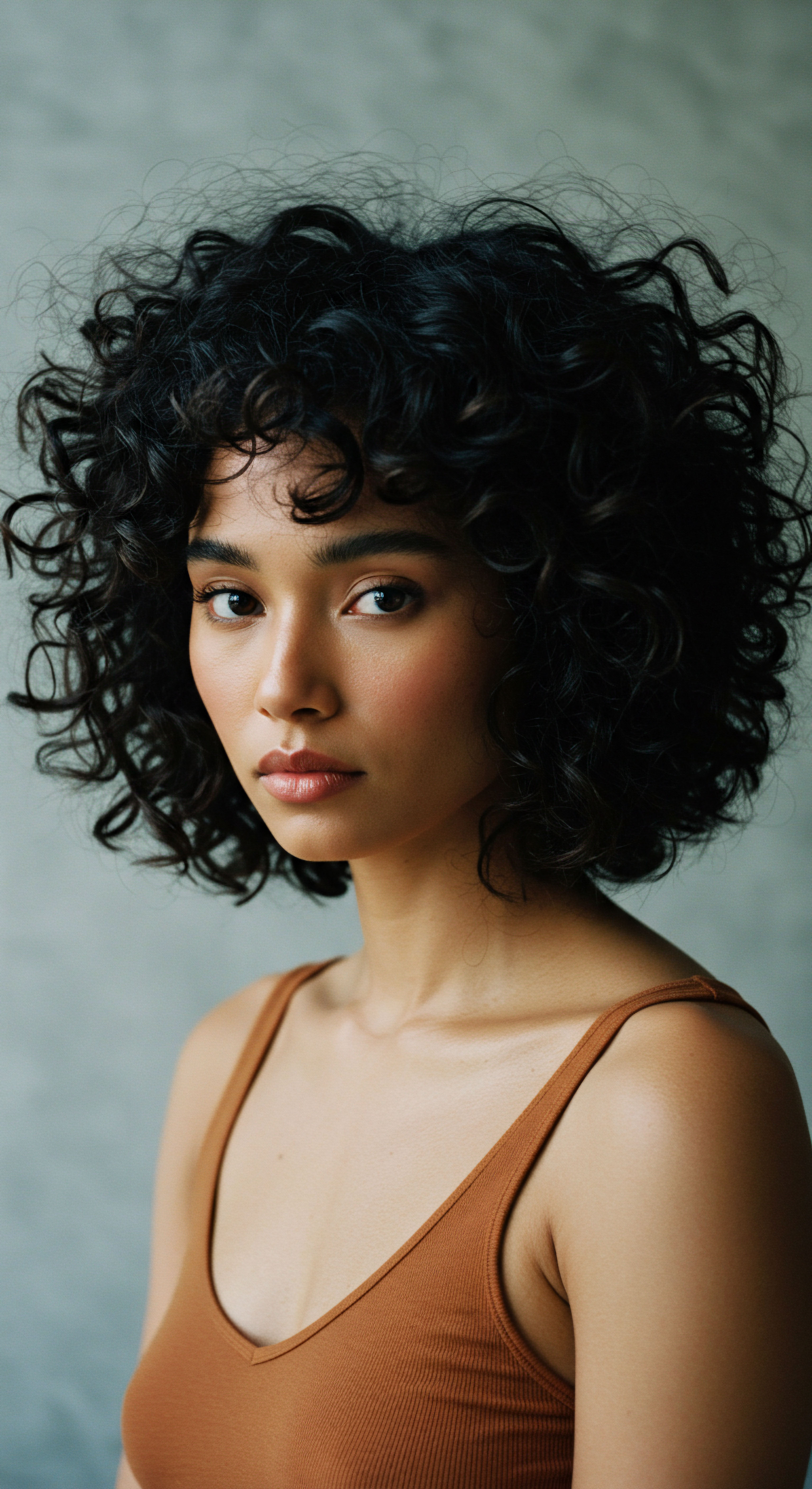
Roots
Our strands, so often admired and adorned, carry more than just style; they bear witness to the world around us. Consider for a moment the very air we breathe in our busy cities—a constant, unseen companion. Does it truly leave its mark on something as delicate as a hair’s moisture?
This inquiry beckons us to look beyond the surface, to the very foundation of our hair’s being, understanding its inner workings as it responds to its external world. To truly grasp the ways urban air influences our hair’s hydration, we must first appreciate the remarkable architecture of each individual strand.

Hair’s Inner Structure
A single hair strand, a slender protein filament, appears simple at first glance. Yet, beneath its visible surface lies a sophisticated design, built to protect and retain its vital water content. The outermost layer, the Cuticle, consists of overlapping scales, much like shingles on a roof. These scales, composed of keratinized cells, typically lie flat and smooth in healthy hair, forming a protective barrier.
This arrangement is crucial for sealing in moisture and reflecting light, giving hair its characteristic sheen. Beneath the cuticle rests the Cortex, which accounts for the majority of the hair’s mass. It comprises tightly packed bundles of keratin proteins, providing strength, elasticity, and housing the melanin responsible for color. At the very core, some hair types possess a central Medulla, a soft, sometimes discontinuous channel. The condition of these layers, particularly the cuticle, dictates how readily hair accepts or loses water.
The surface of hair is also coated with a thin layer of lipids, derived from the scalp’s sebaceous glands. This lipid shield, known as the Sebum Layer, plays a significant part in hair’s natural defense against environmental elements. It acts as a natural conditioner, providing lubrication and helping to repel water, thereby reducing moisture loss from within the hair shaft. When this protective layer is compromised, hair becomes more vulnerable to external stressors.
Hair’s inner structure, from its protective cuticle to its core cortex, determines its inherent ability to hold water.

How Hair Interacts with Atmospheric Water
Hair is a hygroscopic material, meaning it possesses a natural affinity for water. Its protein structure, particularly the keratin within the cortex, can absorb and release water molecules from the surrounding atmosphere. This exchange is a dynamic process, constantly seeking equilibrium with the air’s humidity levels. When the air is humid, hair absorbs moisture, causing the keratin proteins to swell.
For textured hair, this swelling can lead to a phenomenon often described as frizz, as individual strands expand unevenly, disrupting their curl pattern. Conversely, in dry conditions, hair releases its internal water content to the parched air, which can lead to dryness, brittleness, and a lack of suppleness. The delicate balance of water within the hair fiber is constantly influenced by the vapor content of the air around it.
- Cuticle Integrity ❉ A healthy, intact cuticle provides a strong barrier, allowing controlled moisture absorption and retention.
- Hair Porosity ❉ This characteristic, determined by cuticle tightness, governs how easily water enters and exits the hair shaft. Low porosity hair resists water entry, while high porosity hair readily accepts and releases it.
- Hair Type Differences ❉ Textured hair, with its unique bends and curves, often has naturally raised cuticles at these points, making it more susceptible to environmental moisture fluctuations.
The urban environment introduces a variety of elements beyond simple humidity levels, which complicates this natural interaction. Pollutants, temperature shifts, and even direct sunlight play roles in altering the hair’s surface and internal hydration mechanisms. Understanding these fundamental interactions forms the initial step in comprehending the larger influence of city air.
| Hair Component Cuticle |
| Primary Function Outermost protective layer, overlapping scales |
| Relevance to Moisture Controls water entry and exit; flat scales seal in moisture |
| Hair Component Cortex |
| Primary Function Main body of hair, keratin proteins |
| Relevance to Moisture Contains primary water-absorbing proteins; provides strength |
| Hair Component Medulla |
| Primary Function Innermost core (not always present) |
| Relevance to Moisture Role in moisture less direct, contributes to overall mass |
| Hair Component Sebum Layer |
| Primary Function Natural lipid coating on surface |
| Relevance to Moisture Repels water, prevents moisture loss, provides lubrication |
| Hair Component Each part contributes to the hair's capacity to maintain its hydration. |

Ritual
Having explored the foundational elements of hair structure and its inherent responsiveness to atmospheric water, we now shift our attention to the daily and periodic practices that shape our hair’s experience within the urban landscape. The air of cities, often laden with more than just simple humidity, presents a distinctive set of challenges. How, then, do our chosen routines and the products we apply interact with these external forces? This segment delves into the applied wisdom of hair care, offering guidance on how to support hair’s hydration amidst the demands of city living.

Urban Air Pollutants and Hair’s Hydration Barrier
City air contains a cocktail of airborne particles and gases that can directly interfere with hair’s moisture balance. Particulate Matter (PM), microscopic fragments from vehicle exhaust, industrial emissions, and construction, can settle on hair strands. These particles, while seemingly inert, possess reactive surfaces that can adhere to the hair’s cuticle, causing friction and abrasion.
This physical presence can disrupt the smooth alignment of cuticle scales, making the hair’s outer layer rougher and more porous. When the cuticle is compromised, hair becomes less efficient at retaining its internal water, leading to dryness and a dull appearance.
Beyond physical deposition, gaseous pollutants such as ozone and nitrogen dioxide contribute to chemical alterations. Ozone, for instance, is a potent oxidizing agent. It can react with the lipids on the hair’s surface, breaking down the protective sebum layer. This degradation diminishes hair’s natural barrier against moisture loss, leaving it more exposed to environmental drying effects.
Proteins within the hair shaft, particularly those rich in sulfur-containing amino acids like cysteine, are also vulnerable to oxidative attack from pollutants. Damage to these proteins can weaken the hair’s internal structure, further impeding its ability to hold water.
City air carries unseen burdens that directly compromise hair’s ability to retain water.
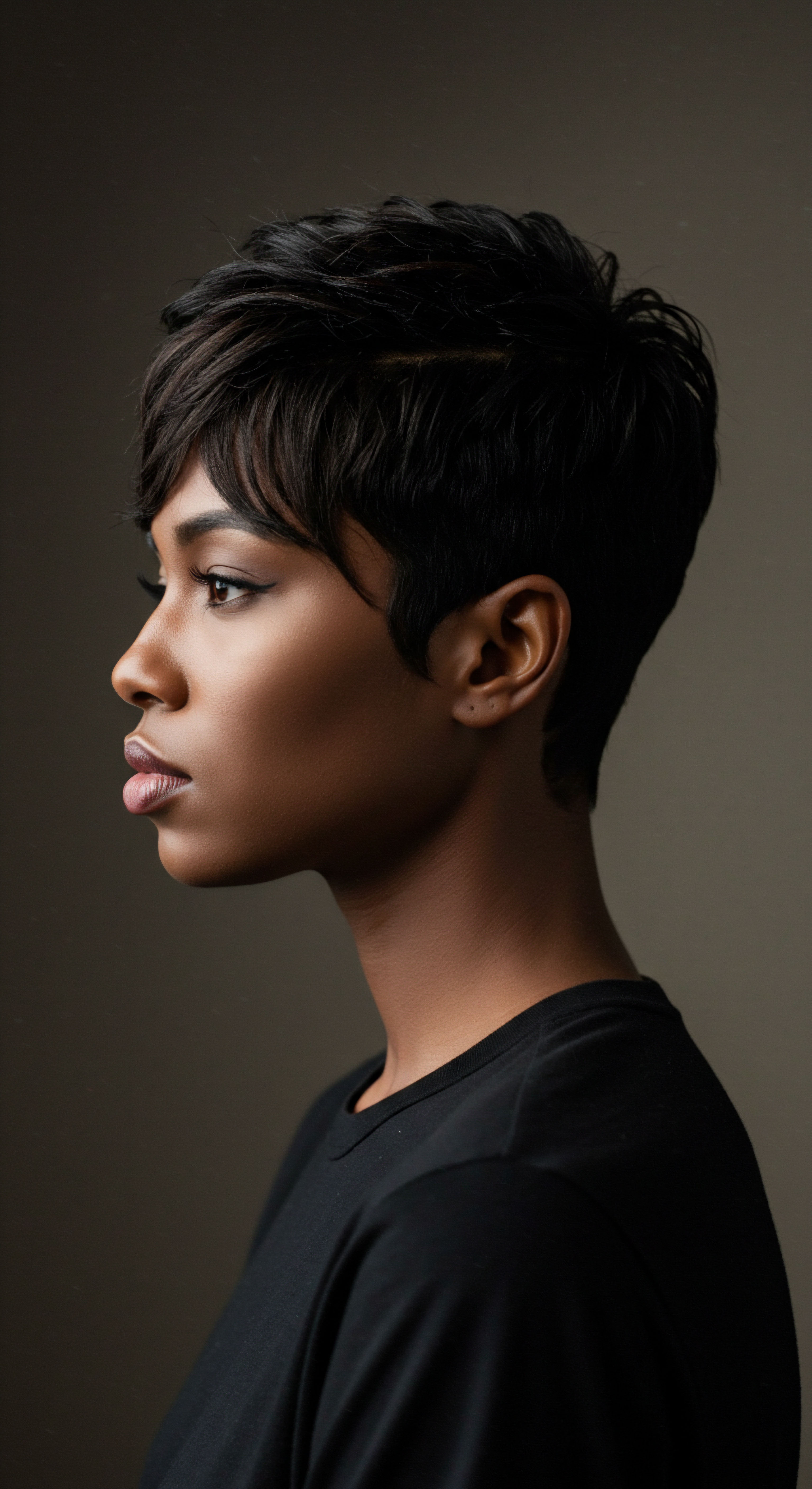
Maintaining Cuticle Harmony
The hair’s cuticle, a guardian of internal hydration, requires specific attention when confronted with urban air. Regular, gentle cleansing becomes paramount to remove accumulated pollutants without stripping essential moisture. A shampoo formulated to clarify without harshness can help dislodge particulate matter and residual chemical deposits.
Following cleansing, conditioning agents work to reseal and smooth the cuticle, restoring its protective function. Ingredients such as fatty alcohols, silicones, and various protein derivatives can help coat the hair shaft, mimicking the natural lipid layer and offering a shield against external aggressors.
- Gentle Cleansing ❉ Select shampoos designed to remove urban deposits without stripping natural oils.
- Deep Conditioning ❉ Regular use of conditioning treatments helps restore the cuticle’s integrity and suppleness.
- Leave-In Protection ❉ Apply leave-in products with barrier-forming ingredients before stepping into polluted environments.
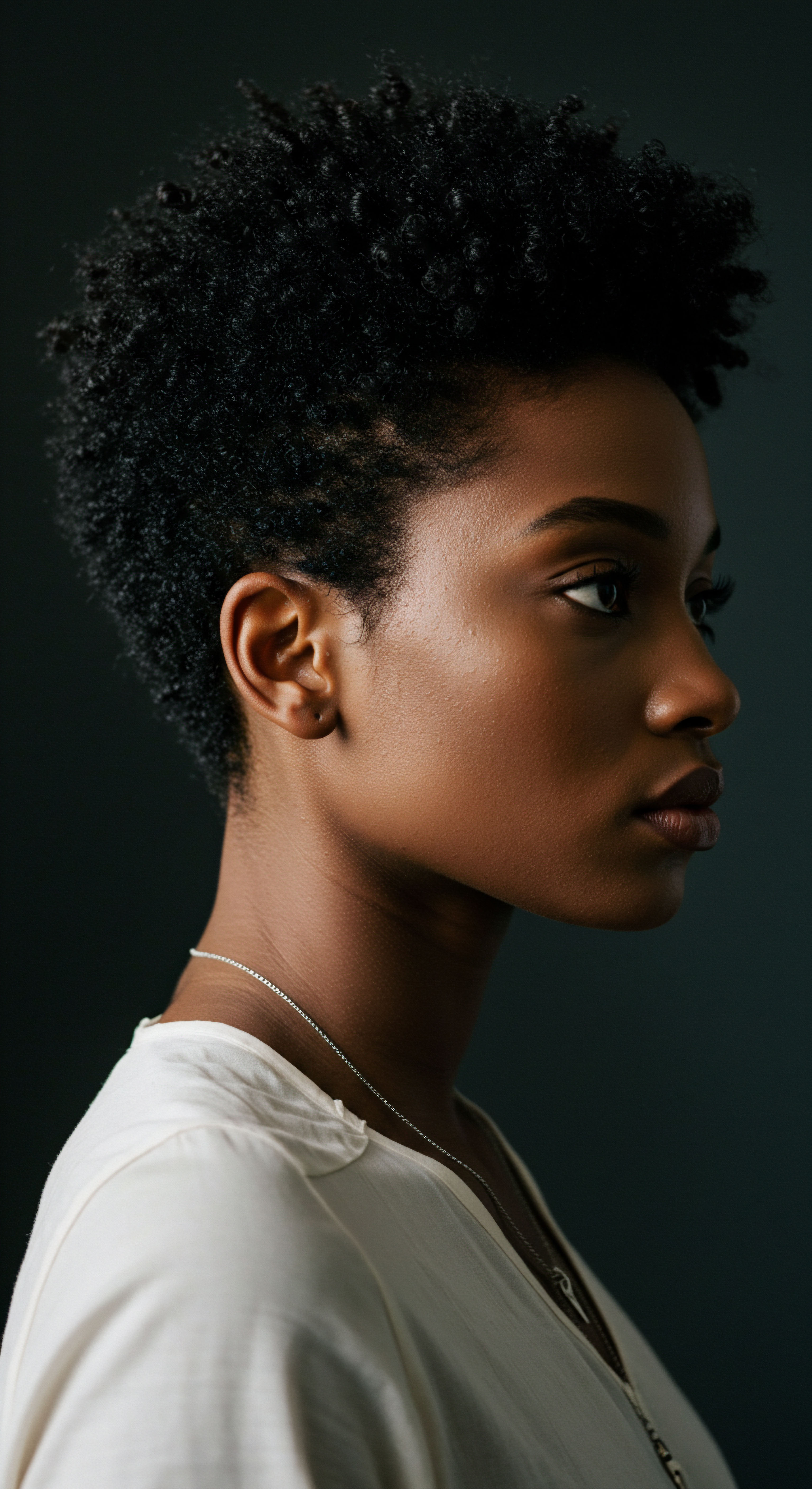
Humidity’s Double-Edged Blade
The relationship between urban humidity and hair moisture is complex. In moderately humid environments, hair might draw in atmospheric water, appearing softer and more supple. Yet, for textured hair, too much humidity, particularly when combined with pollution, can lead to undesirable effects. High humidity causes the hair shaft to swell.
If the cuticle is already compromised by pollutants, this swelling can be uneven, resulting in frizz and a lack of definition. The external water molecules sit on the hair’s surface rather than truly penetrating, leading to a superficial dampness that does not translate to deep hydration.
Conversely, in very dry urban climates, the air acts as a sponge, pulling moisture from hair. This rapid dehydration can leave hair feeling brittle, rough, and prone to breakage. The dry air also carries particulate matter more easily, allowing it to settle on hair with less resistance from atmospheric moisture.
| Humidity Level High Humidity |
| Effect on Hair Hair absorbs surface moisture, swells, frizz may occur, especially if cuticles are lifted. |
| Suggested Approach Use anti-humectants or products that seal the cuticle to prevent excessive water absorption. |
| Humidity Level Low Humidity |
| Effect on Hair Hair loses internal moisture to the dry air, becoming brittle and dry. |
| Suggested Approach Apply humectant-containing products to attract water, followed by emollients to seal. |
| Humidity Level Adapting care to ambient humidity is a step towards hair well-being. |

Why do Some Hair Types React More to Humidity?
Textured hair, with its varied curl patterns and natural tendency for lifted cuticles, often exhibits a more pronounced response to changes in humidity. The unique helical structure of these strands means that water absorption can happen unevenly along the length of a single fiber, leading to differential swelling. This differential swelling creates internal stress within the hair shaft, contributing to frizz and a disruption of the curl’s integrity.
The greater the difference in humidity between the hair’s internal moisture and the surrounding air, the more dramatic the hair’s response. Urban environments, with their fluctuating temperatures and pollutant loads, can amplify these natural responses, making consistent moisture regulation a central theme for hair well-being.

Relay
Our understanding of hair’s relationship with its environment extends beyond the immediate touch of air and water. It reaches into the very composition of the urban atmosphere, revealing a complex interplay of forces that quietly shape our strands. To truly grasp how city air affects hair moisture, we must consider the invisible constituents of that air, the scientific mechanisms at play, and the broader societal implications of our metropolitan existence. This exploration calls for a look at the less obvious, yet potent, agents influencing hair’s vitality.
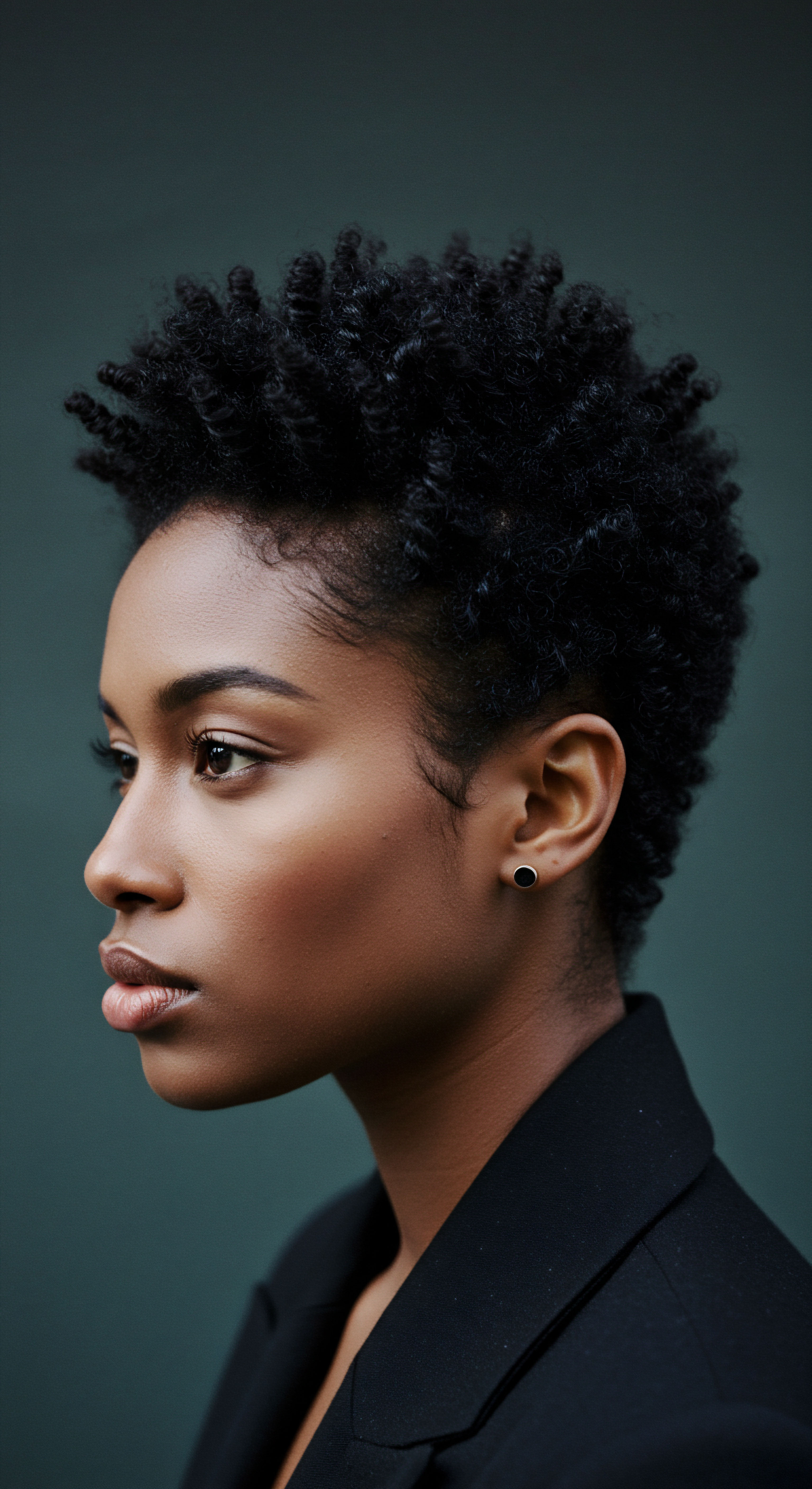
The Unseen Adversaries in City Air
Urban air is a dynamic mixture, not just of gases but also of microscopic particles and chemical compounds. These components, products of combustion, industrial activity, and even natural dust, pose a persistent challenge to hair’s delicate balance. Among these, Polycyclic Aromatic Hydrocarbons (PAHs), heavy metals, and various volatile organic compounds (VOCs) are particularly noteworthy.
These substances, often adsorbed onto fine particulate matter, can settle on the hair and scalp. Their presence initiates a cascade of detrimental reactions that directly compromise hair’s moisture-retaining capabilities.
The interaction begins at the hair’s surface. Particulate matter, especially PM2.5 (particles smaller than 2.5 micrometers), is tiny enough to adhere to the hair shaft and even infiltrate the scalp. This physical adherence causes surface roughness, increasing friction between strands and diminishing their natural slip and shine. Beyond physical irritation, these pollutants act as catalysts for chemical damage.
They can generate Reactive Oxygen Species (ROS), often termed free radicals, which initiate a process called oxidative stress. Oxidative stress is a cellular imbalance where the production of damaging free radicals overwhelms the body’s ability to neutralize them.
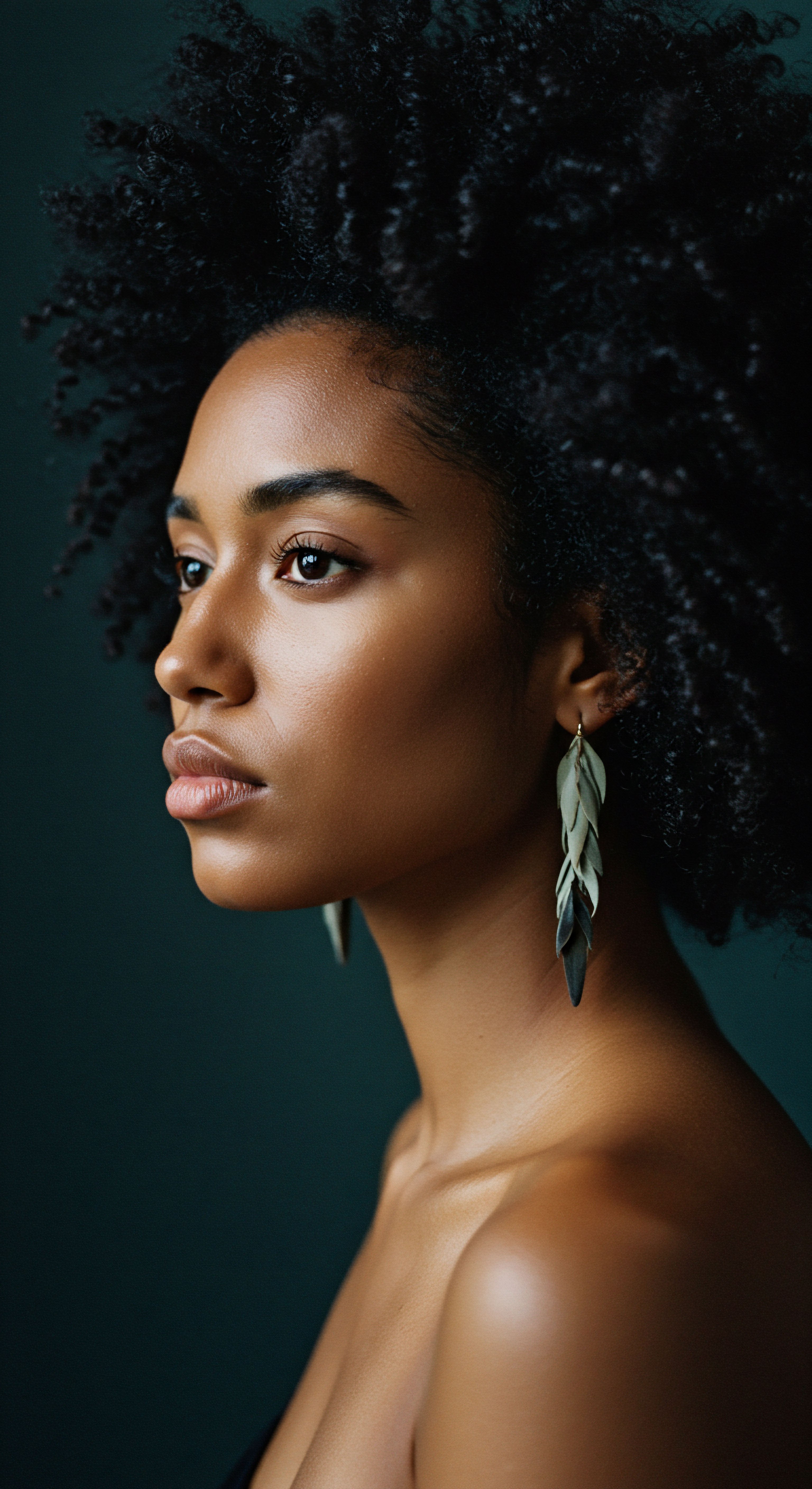
How do Air Pollutants Chemically Alter Hair Structure?
The chemical assault on hair primarily targets its protein backbone, keratin, and its protective lipid layer. Oxidative stress, triggered by pollutants like ozone and heavy metals, causes irreversible damage to hair proteins. For instance, studies indicate that ozone can oxidize amino acid residues such as cysteine, methionine, and tryptophan within the hair shaft. Cysteine, crucial for the disulfide bonds that give hair its strength and shape, is particularly vulnerable.
When these bonds are broken or altered, the hair’s structural integrity weakens, making it more porous and less able to hold onto moisture. This damage extends to the cell membrane complex (CMC), a lipid-rich region that acts as an intercellular cement within the cuticle layers. Degradation of the CMC leads to lifted cuticles, creating pathways for moisture to escape and external aggressors to enter.
Furthermore, heavy metals, often found in higher concentrations in urban environments, can deposit onto hair. Research has shown that these metals can act as pro-oxidants, accelerating the generation of free radicals and intensifying the damage to hair proteins and lipids. This continuous exposure leads to a decline in hair quality, affecting its texture, elasticity, and overall ability to remain hydrated. The hair becomes drier, more brittle, and susceptible to breakage.
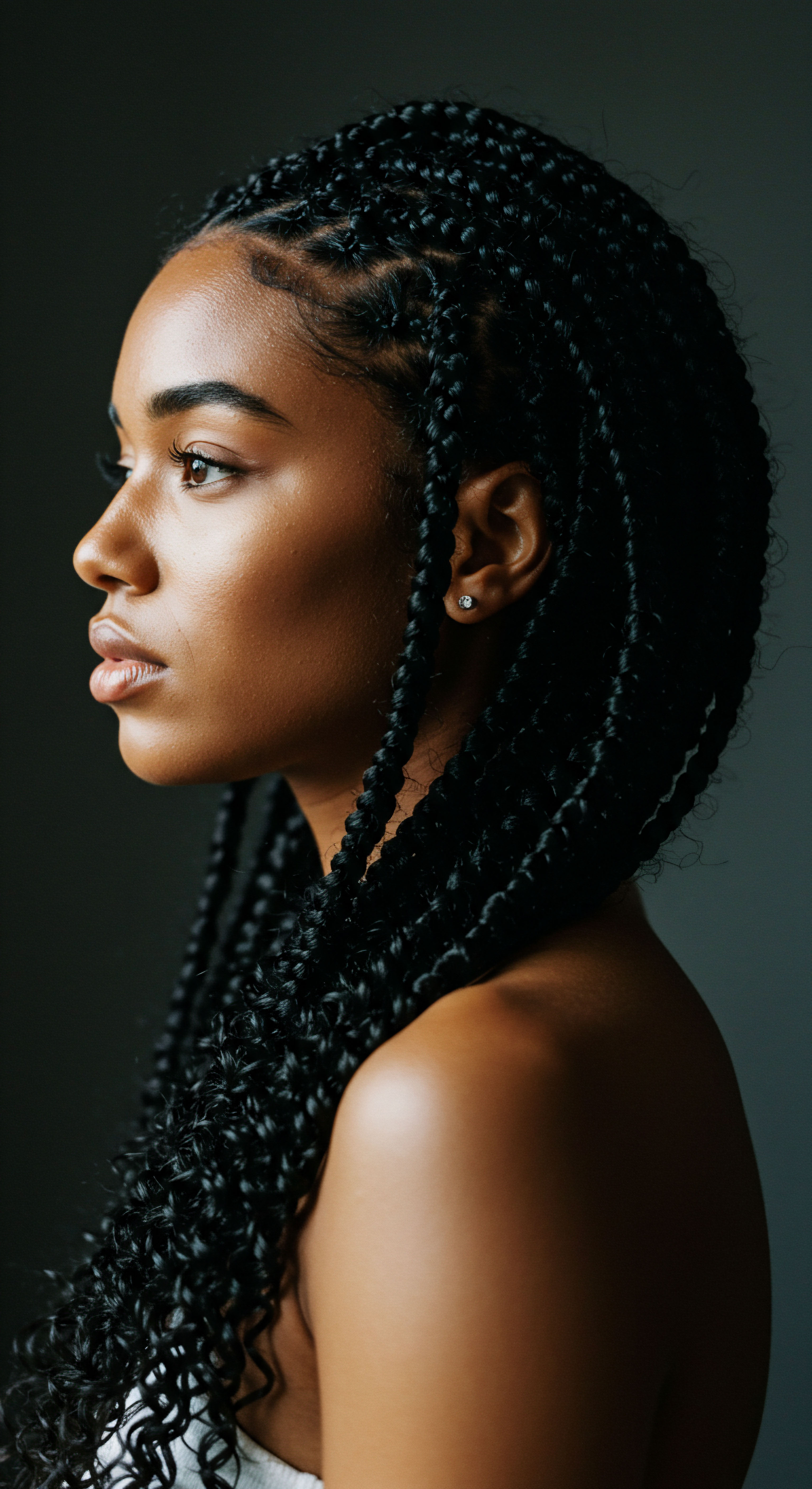
Hair as a Bioindicator of Urban Exposure
Perhaps one of the most compelling, yet often overlooked, aspects of urban air’s influence is hair’s capacity to serve as a record of environmental exposure. Hair fibers, as they grow, absorb and accumulate various substances from the surrounding environment and the body’s internal systems. This makes hair a unique biological monitor for long-term exposure to pollutants.
Consider a study conducted in Milan, Italy, which examined the deposition of particulate matter and heavy metals on human hair. Researchers discovered that the concentration of fine particulate matter and heavy metals deposited on hair was 1.5 Times Higher Than the Levels Found in the Air, and the amount deposited on the scalp was double the levels in the air. This data point underscores hair’s remarkable ability to act as a sponge for urban contaminants.
It implies that even if we cannot see the pollution, our hair is actively collecting it, providing a silent testimony to our daily environmental interactions. This phenomenon extends to various heavy metals like lead, cadmium, and arsenic, whose presence in hair samples from urban populations has been correlated with environmental load.
The implication for hair moisture is significant. When hair becomes a repository for these external elements, its surface properties change. It becomes more hydrophilic (water-attracting) on the outside due to damaged lipids and proteins, yet simultaneously struggles to retain water within its compromised structure.
This leads to a paradoxical state where hair feels dry despite being exposed to moisture, or appears dull even after conditioning. The accumulated pollutants can also irritate the scalp, leading to inflammation, which can indirectly affect the hair follicle’s ability to produce healthy, well-hydrated strands.
Hair acts as a silent environmental recorder, accumulating urban pollutants that disrupt its inherent hydration mechanisms.
This deeper understanding of hair as a bioindicator shifts our perspective. Our hair is not merely a passive recipient of urban air; it actively interacts with and stores its components. Recognizing this reality compels a more informed approach to hair care, one that acknowledges the constant, unseen battles our strands wage against the very air we breathe in our city lives.
| Pollutant Type Particulate Matter (PM) |
| Mechanism of Harm Physical adhesion, abrasion, irritation of scalp/follicles. |
| Effect on Hair Moisture & Condition Increased surface roughness, dullness, reduced shine, potential hair loss. |
| Pollutant Type Ozone (O3) |
| Mechanism of Harm Oxidative stress, reaction with lipids and proteins. |
| Effect on Hair Moisture & Condition Degradation of protective sebum, weakened protein structure, increased porosity. |
| Pollutant Type Heavy Metals (e.g. Lead, Cadmium) |
| Mechanism of Harm Pro-oxidant activity, accumulation in hair shaft. |
| Effect on Hair Moisture & Condition Accelerated protein/lipid damage, altered texture, brittleness, dryness. |
| Pollutant Type Polycyclic Aromatic Hydrocarbons (PAHs) |
| Mechanism of Harm Adsorption onto hair, generation of reactive oxygen species. |
| Effect on Hair Moisture & Condition Compromised cuticle, increased structural degradation, loss of moisture retention. |
| Pollutant Type These agents collectively diminish hair's capacity to maintain its natural water balance. |
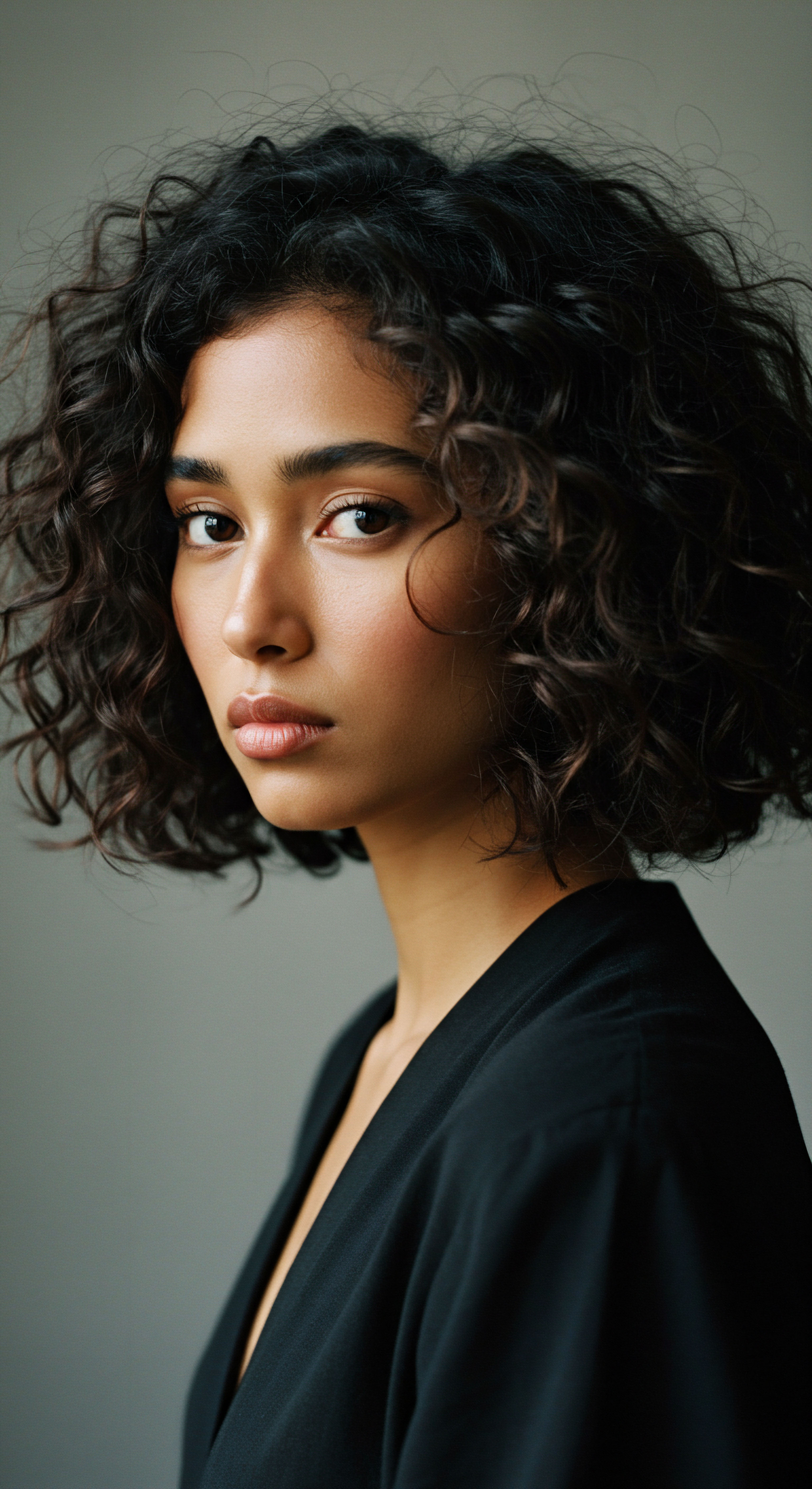
Reflection
As we conclude our exploration of urban air’s subtle yet profound influence on hair moisture, a deeper appreciation for our strands takes root. Our hair, far from being a mere aesthetic feature, serves as a delicate barometer, reflecting the invisible forces that surround us in our bustling cities. It reminds us that our bodies, down to each individual strand, are in constant conversation with the environment.
The quest for hydrated, healthy hair in urban settings becomes a practice of mindful awareness, a quiet acknowledgement of the world’s presence and its gentle imprints. It is a call to nurture, to protect, and to honor the resilience of our hair as it gracefully navigates the currents of modern life.

References
- Rajput, R. (2015). Understanding Hair Loss due to Air Pollution and the Approach to Management. Hair Therapy & Transplant, 5:133.
- Son, E. & Kwon, K. H. (2025). The Invisible Threat to Hair and Scalp from Air Pollution. Polish Journal of Environmental Studies, 34(4), 1745-1756.
- Naudin, C. et al. (2019). Human pollution exposure correlates with accelerated ultrastructural degradation of hair fibers. Proceedings of the National Academy of Sciences, 116(37), 18367-18372.
- Yang, S. J. Yu, H. J. Lee, J. Hwang, S. J. & Jeong, E. T. (2024). Effects of ultraviolet rays and particulate matter on hair porosity in damaged hair. Journal of Cosmetic Dermatology.
- Baaijens, F. P. T. Govaert, L. E. Ackermans, P. A. J. & Asvadi, S. (2003). The influence of humidity on the viscoelastic behavior of human hair. Biorheology, 40(4), 431-439.
- Zahoor, M. & Rahman, A. (2019). Heavy Metal Accumulation in Dust and Workers’ Scalp Hair as a Bioindicator for Air Pollution from a Steel Factory. Polish Journal of Environmental Studies, 28(4), 2805-2811.
- Okonkwo, D. O. et al. (2024). The Genomic Variation in Textured Hair ❉ Implications in Developing a Holistic Hair Care Routine. Cosmetics, 11(6), 183.
- Sivaramakrishnan, M. & Rao, A. (2022). Hair Care. National Council of Educational Research and Training (NCERT).
- Viebke, C. et al. (2020). All-day hair manageability for textured hair types ❉ A revision of the current anti-frizz technologies and suggestions for the future. International Journal of Cosmetic Science, 42(3), 221-230.
- O’Brien, M. et al. (2018). Effect of humidity on photoinduced radicals in human hair. Free Radical Biology and Medicine, 121, 20-25.
- Kozak, M. et al. (2003). Study of the content of heavy metals related to environmental load in urban areas in Slovakia. Veterinarni Medicina, 48(12), 333-338.
- Mladenovska, K. et al. (2011). Examination of the content of heavy metals using hair samples in dogs of urban areas of Macedonia. Veterinary World, 4(6), 263-266.
- Molina-Navarro, E. et al. (2014). Urban ecosystem services and climate change ❉ a dynamic interplay. Frontiers in Ecology and the Environment.
- Girard, L. F. & Nocca, F. (2020). Climate Change and Health Impacts in Urban Areas ❉ Towards Hybrid Evaluation Tools for New Governance. Atmosphere, 11(12), 1344.
- Aydemir, O. & Yilmaz, E. (2018). Oxidation of Amino Acids, Peptides and Proteins by Ozone ❉ A Review. ResearchGate.